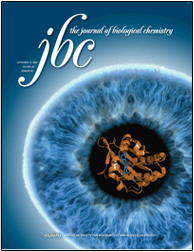 The structural analysis of protein molecules is one of the many fortes of the Klevit laboratory. For your convienience, a complete collection of our solved protein structural data has been obtained from the Protein Databank (www.pdb.org) and been made available for direct-download below. File data may be opened/viewed with any type molecular visualization software currently installed on your system. If you do not already have this type of software, it is highly recommended that either you or your system administrator download and install PyMOL, RasMOL, MolMOL, and/or Chimera from their respective websites. Enjoy!
The structural analysis of protein molecules is one of the many fortes of the Klevit laboratory. For your convienience, a complete collection of our solved protein structural data has been obtained from the Protein Databank (www.pdb.org) and been made available for direct-download below. File data may be opened/viewed with any type molecular visualization software currently installed on your system. If you do not already have this type of software, it is highly recommended that either you or your system administrator download and install PyMOL, RasMOL, MolMOL, and/or Chimera from their respective websites. Enjoy!
|
E4BU:UbcH5c-O~Ubiquitin Model HADDOCK model of the activated E4BU:UbcH5c-O~Ubiquitin ternary complex, based on NMR chemical shift perturbations and confirmed with paramagnetic relaxation experiments. Though not reflected in the posted coordinate file, experimental data were collected using the UbcH5c C85S mutation to extend the lifetime of the conjugated species and the UbcH5c S22R mutation to prevent noncovalent self-assembly. Please cite Pruneda et al., Mol. Cell 2012 |
|
UbcH5c-O~Ubiquitin SAXS Ensemble Ensemble of 20 UbcH5c-O~Ubiquitin conformations that together best fit small angle X-ray scattering data according to the ensemble optimization method. Though not reflected in the posted coordinate file, experimental data were collected using the UbcH5c C85S mutation to extend the lifetime of the conjugated species and the UbcH5c S22R mutation to prevent noncovalent self-assembly. As a disclaimer, SAXS modeling cannot distinguish the “twist” of the ubiquitin moiety with respect to UbcH5c, only the general orientation. Please cite Pruneda and Stoll et al., Biochemistry 2011 |
|
Ubc13-O~Ubiquitin SAXS Ensemble Ensemble of 20 Ubc13-O~Ubiquitin conformations that together best fit small angle X-ray scattering data according to the ensemble optimization method. Though not reflected in the posted coordinate file, experimental data were collected using the Ubc13 C87S mutation to extend the lifetime of the conjugated species. As a disclaimer, SAXS modeling cannot distinguish the “twist” of the ubiquitin moiety with respect to Ubc13, only the general orientation. Please cite Pruneda and Stoll et al., Biochemistry 2011 |
| AlphaB-Crystallin Oligomer Model Model of the human small heat shock protein, alphaB-crystallin oligomer, based on solid-state NMR, SAXS, and negative-stain EM. Please cite Jehle et al., Proc Natl Acad Sci USA 2011 |
| BRCA1/BARD1 RING-domains (ID:1JM7) Solution structure of the BRCA1/BARD1 heterodimeric RING-RING complex as determined by solution NMR. |
| Alpha-Crystallin Domain (ID: 2KLR) Solid-state NMR structure of the alpha-crystallin domain in alphaB-crystallin oligomers. Structure was determined via solid-state NMR spectroscopy. |
| UbcH5c/Ub Complex (ID: 2FUH) Solution Structure of the UbcH5c/Ub Non-covalent Complex as determined by solution NMR. |
| DNA-Binding Domain Zinc Finger Mutant (ID: 1ARD) Structures of DNA Binding Zinc Finger Domain: Implications for DNA Binding. Structures were solved using solution NMR. |
| DNA-Binding Domain Zinc Finger Mutant (ID: 1ARE) Structures of DNA Binding Zinc Finger Domain: Implications for DNA Binding. Structures were solved using solution NMR. |
| DNA-Binding Domain Zinc Finger Mutant (ID: 1ARF) Structures of DNA Binding Zinc Finger Domain: Implications for DNA Binding. Structures were solved using solution NMR |
| Sodium Channel IIA Inactivation Gate (ID: 1BYY) Solution NMR Structure of the sodium channel inactivation gate. |
| His-Phosporylated Phosphocarrier Histidine from B.subtilis (ID: 1JEM) Phosphorylation on histidine is accompanied by localized structural changes in the phosphocarrier protein, HPr from Bacillus subtilis |
| Histidine-X4-histidine Zinc Finger Domain (ID: 1PAA) Model of the solution structure of a histidine-X4-histidine zinc finger domain: insights into ADR1-UAS1 protein-DNA recognition. |
| PhoQ Sensor Domain w/ Calcium (ID: 1YAX) Metal bridges between the PhoQ sensor domain and the membrane regulate transmembrane signaling. Solved with X-RAY diffraction with a resolution of 2.40 angstroms. |
| ADR1 DNA-Binding Domain for S.cerevisiae (ID: 2ADR) A folding transition and novel zinc finger accessory domain in the transcription factor ADR1. |
| M3 Muscarinic Acetylcholine Receptor (ID: 2CSA) M3 Identification and structural determination of the M3 muscarinic acetylcholine receptor basolateral sorting signal as observed by solution NMR. |
| Refined Structure of Phosphocarrier Protein (ID: 2HID) Phosphorylation on histidine is accompanied by localized structural changes in the phosphocarrier protein, HPr from Bacillus subtilis. |
| cGMP-binding GAF Domain – Phosphodiesterase 5 (ID: 2K31) Solution Structure of the cGMP Binding GAF Domain from Phosphodiesterase 5: Insights into Nucleotide Selectivity, Dimerization, and cGMP-Dependent Conformational Change. |
| U-box domain of the E3 Ubiquitin Ligase E4B (ID: 2KO4) Structural and functional characterization of the monomeric U-box domain from E4B as observed through solution NMR. |
| Crystal Structure of the BARD1 Ankyrin Repeat Domain (ID: 3C5R) Crystal Structure of the BARD1 Ankyrin Repeat Domain and Its Functional Consequences. |
| cGMP-bound GAF a domain from photoreceptor phosphodiesterase 6C (ID: 3DBA) The Structure of the GAF A Domain from Phosphodiesterase 6C Reveals Determinants of cGMP Binding, a Conserved Binding Surface, and a Large cGMP-dependent Conformational Change |
| BRCA1 Associated Ring Domain (BARD1) Tandem BRCT Domains (ID: 3FA2) Crystal Structure of the BRCA1 Associated Ring Domain (BARD1) Tandem BRCT Domains as determined by X-Ray diffraction with a resolution of 2.20 angstroms. |




